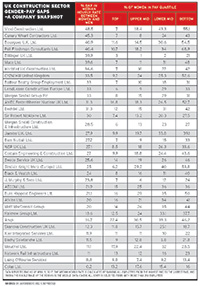Industry CEOs offered varied response to new statistics that show the imbalance between men and women in the U.K. construction sector. The issue came into renewed focus earlier this month as more than 10,000 firms with more than 250 employees submitted first-of-its-kind government-mandated reports on compensation by gender.
Construction came out the worst of 27 business sectors, with a 24% median gap in hourly pay, says the analysis by human resources consultant Staffmetrix, Edinburgh (See company-by-company statistics in chart below.)
 |
| Click to view larger image |
Among firms in all sectors, the pay gap averaged about 10%, but it was as high as 59% in financial services.
Some have criticized the data as simplistic.
Using the average wage for men and women “serves more to highlight the lack of females in the workforce rather than the difference in pay that the name suggests,” said Gill Parker, the female CEO of BDG architecture + design, in an April 6 U.K. industry web post.
However, the data "highlights that women get so far up an organization and then stop progressing,” says a Staffmetrix spokesman.
“There is a lot to be done to ensure we are attracting, recruiting and retaining talented women into the full range of roles and at all levels,” says Leo Quinn, CEO of Balfour Beatty plc, the U.K.’s largest contractor, which reported a 33% median gender-pay gap and a 65% disparity in median bonus payments (see chart above).
The required compensation “snapshot,” relating to April 2017, included median and mean gaps in hourly pay, the proportion of women in each wage-rate quartile and bonus differences.
In a selection of leading contractors, ENR analysis revealed that women’s median hourly pay was, on average, 28% below men’s. The corresponding average gap among a selection of design firms was 14%.
Among those contractors, the reported median hourly pay-rate gap ranged from over 48.5% to 0.2%. The proportion of women in the top pay quartile ranged from 3% to nearly 17%.
Women generally were among the lowest earners, accounting for up to 70% of the lower quartile.
In the sample of design firms ENR analyzed, the median hourly gap ranged from 33.5% down to 11% and the proportion of women in the top quartile from 6.2% to 22%.
Brian Britton, a materials science lecturer at London University, says the data on a government website “enables companies to look across the sector and ask questions about what’s important with respect to equality.”
For Balfour Beatty, plugging the pay gap is necessary to recruit more women to fill growing skills shortages.
Women make up only 13% of the firm’s workforce, with a smaller fraction on site, it says. Balfour Beatty says the number of women in senior construction industry roles has doubled since 2005, but they occupy only 16% of those posts. Women also make up less than 2% of apprentices.
Construction “remains one of the worst in the U.K. in terms of gender balance,” notes CEO Quinn.
But attracting more women would be “only a partial victory if they are confined to lower levels of the corporate hierarchy,” Balfour Beatty says in its report.
“The gender issue is being addressed by the majority of companies but it can’t happen overnight. Businesses are now dealing with the result of commonplace practice bias from over 30 years ago,” Parker notes. “This is an exciting time for women in the workplace, let’s not get distracted by potentially misleading stats and keep moving forward. Men and women—we are in it together.”
Date on individual companies can be accessed here.







Post a comment to this article
Report Abusive Comment